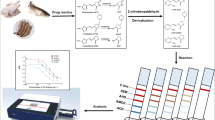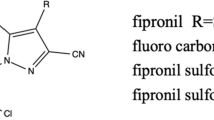Abstract
A time-resolved fluoroimmunoassay (TRFIA) technique was developed to detect chloramphenicol (CAP) contamination in food. By using CAP-ovalbumin, anti-CAP antibodies, and europium-labelled goat anti-rabbit antibodies, an indirect, competitive method for CAP-TRFIA was established. The sensitivity was high, with a detection limit of 0.008 μg/L (8 ppt) for indirect competitive TRFIA formats. Testing showed that the sensitivity of the technique was 2.67 μg/kg in honey, prawn, and chicken muscle tissues, and 0.32 μg/L in milk. The detection range was between 0.008 and 100 μg/L: within this, the intra- and inter-batch coefficients of variation of the CAP-TRFIA method were 6.8 and 13.5 %, respectively. The study suggested that CAP-TRFIA was a simple, sensitive, and cost-effective method of screening large quantities of samples and had good prospects for further application.





Similar content being viewed by others
References
Franklin TJ, Snow GA (1989) Biochemistry of antimicrobial action, 4th edn. Chapman & Hall, London, p 128
Li SG, Li XM, Chen H, Chen XW (2003) Animal food and HACCP. Food Sci 24(8):217–220
Nang QX, Lv L (2002) Animal food safety problem and countermeasure. China Poult 24(22):6–8
2002/249/EC: Commission decision of 27 March 2002 concerning certain protective measures with regard to certain fishery and aquaculture products intended for human consumption and imported from Myanmar. Off J L84:73–74
2002/250/EC: Commission decision of 27 March 2002 concerning the extension of the protective measures provided by Decision 2001/699/EC with regard to certain fishery and aquaculture products imported from Vietnam. Off J L84:75–76
2002/251/EC: Commission decision of 27 March 2002 concerning certain protective measures with regard to poultry meat and certain fishery and aquaculture products intended for human consumption and imported from Thailand. Off J L84:77–78
European Community Regulations, 2377/90 (1990), Annex IV, and 1430/94 (1994)
Hummert C, Luckas B, Siebenlist H (1995) Determination of chloramphenicol in animal tissue using high-performance liquid chromatography with a column-switching system and ultraviolet detection. J Chromatogr B Biomed Appl 668:53–58
Nagata T, Saeki M (1992) Simultaneous determination of thiamphenicol, florfenicol, and chloramphenicol residues in muscles of animals and cultured fish by liquid chromatography. J Liq Chromatogr 15(12):2045–2056
Posyniak A, Zmudzki J, Niedzielska J (2003) Evaluation of sample preparation for control of chloramphenicol residues in porcine tissues by enzyme-linked immunosorbent assay and liquid chromatography. Anal Chim Acta 483:307–311
Humayoun AM, Claude D, Andre S et al (1995) Gas chromatographic determination of incurred Chloramphenicol residues in eggs following optimal extraction. J Chromatogr A 696:123–130
Gude T, Preiss A, Rubach K (1995) Determination of chloramphenicol in muscle, liver, kidney and urine of pigs by means of immunoaffinity chromatography and gas chromatography with electron-capture detection. J Chromatogr B Biomed Appl 673:197–204
Ding SY, Shen JZ, Zhang SX, Jiang HY, Sun ZW (2005) Determination of chloramphenicol residue in fish and shrimp tissues by gas chromatography with a microcell electron capture detector. AOAC Int 88:57–60
Shen HY, Jiang HL (2005) Screening determination and confirmation of chloramphenicol in seafood, meat and honey using ELISA, HPLC–UVD, GC–ECD, GC–MS–EI–SIM and GCMSNCI–SIM methods. Anal Chim Acta 535:33–41
Bogusz MJ, Hassan H, Al-Enazi E, Ibrahim Z, Al-Tufail M (2004) Rapid determination of chloramphenicol and its glucuronide in food products by liquid chromatography–electrospray negative ionization tandem mass spectrometry. J Chromatogr B Analyt Technol Biomed Life Sci 807:343–356
Kolosova AY, Samsonova JV, Egorov AM (2000) Competitive ELISA of chloramphenicol: influence of immunoreagent structure and application of the method for the inspection of food of animal origin. Food Agric Immunol 12:115–125
Gaudin V, Cadieu N, Maris P (2004) Inter-laboratory studies for the evaluation of ELISA kits for the detection of chloramphenicol residues in milk and muscle. Food Agric Immunol 15:143–157
Soini E, Kojola H (1983) Time-resolved fluorometer for lanthanide chelates—a new generation of nonisotopic immunoassays. Clin Chem 29:65–68
Hu MY, Liang GL, Yu YH et al (2001) Synthesis of β-NTA and research of enhancement solution of time-resolved fluoroimmunoassay. Chin J Nucl Med 21:244
Forti AF, Gampana G, Simonella A, Multari M, Scortichini G (2005) Determination of chloramphenicol in honey by liquid chromatography–tandem mass spectrometry. Anal Chim Acta 529:257–263
Conflict of interest
None.
Compliance with Ethics Requirements
This article does not contain any studies with human subjects. All institutional and national guidelines for the care and use of laboratory animals were followed.
Author information
Authors and Affiliations
Corresponding author
Rights and permissions
About this article
Cite this article
Zhou, B., Zhang, J., Fan, J. et al. A new sensitive method for the detection of chloramphenicol in food using time-resolved fluoroimmunoassay. Eur Food Res Technol 240, 619–625 (2015). https://doi.org/10.1007/s00217-014-2363-0
Received:
Revised:
Accepted:
Published:
Issue Date:
DOI: https://doi.org/10.1007/s00217-014-2363-0




